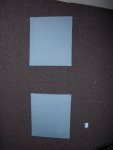Doowah
New member
As part of my continuing education since joining this most excellent forum, I've recently come to the realization that I'm gonna need to install some sound treatment in my 12' x 10' x 8' (ceiling height) little box of a spare bedroom home recording studio. So, I've followed all of the recent and past threads on this forum regarding the subject of room treatment, and I've read everything that I could find that was written by Ethan Winer on the Internet. I think that I need to mount several panels of OC703/705 (or equivalents) on my walls to act as absorbers, and build bass traps in the corners of the room using the same materials.
I also see that most folks cover this rigid fiberglass material with some kind of fabric, or build a frame of wood and fabric to put over the fiberglass panels. I'm assuming that the covering is strictly for aesthetic reasons, and that it isn't strictly necessary for the sound treatment to function correctly. Is that a valid assumption, or am I missing some point? If this extra investment in money, time, labor and materials is strictly to make the panels "look good", can I just mount the raw panels in place and forget about it?
Sorry if this is a dumb question, which may very well be the case since the whole concept of room treatment is brand new to me. But if I can get the benefits without fooling around with the fabric covering, it gets me a lot closer to getting this done. (I'm handicapped and physical labor is "difficult", but not impossible.) If I don't care what it looks like, but I can help my room acoustics anyway, that would be super. If I'm nuts, please feel free to let me know (but please take the time to educate me, too).
Thanks!
I also see that most folks cover this rigid fiberglass material with some kind of fabric, or build a frame of wood and fabric to put over the fiberglass panels. I'm assuming that the covering is strictly for aesthetic reasons, and that it isn't strictly necessary for the sound treatment to function correctly. Is that a valid assumption, or am I missing some point? If this extra investment in money, time, labor and materials is strictly to make the panels "look good", can I just mount the raw panels in place and forget about it?
Sorry if this is a dumb question, which may very well be the case since the whole concept of room treatment is brand new to me. But if I can get the benefits without fooling around with the fabric covering, it gets me a lot closer to getting this done. (I'm handicapped and physical labor is "difficult", but not impossible.) If I don't care what it looks like, but I can help my room acoustics anyway, that would be super. If I'm nuts, please feel free to let me know (but please take the time to educate me, too).
Thanks!



